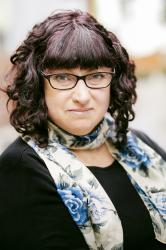The Blue Dragon
The Blue Dragon was my first experience of Canadian theatrical-legend Robert LePage’s thearte. Twitter tells me that it’s not his best work and that I should be disappointed. I wasn’t. I see a lot of works about middle age, middle class angst and disappointment in Melbourne and this is one of few that felt real enough to make me care.
MELBOURNE INTERNATIONAL ARTS FESTIVAL 2010 IntimacyThe Arts Centre, Playhouse 9 October 2010 
The technical mastery and visual wonder of Dragon has been and will be raved about by others. Splitting the stage horizontally, allowed for scene changes as tight as a brilliantly edited film, locations as intimate as an apartment and as vast as the Shanghai skyline and, being a multi-language script, placed subtitles as midtitles at eye level; leaving the audience able to read and watch at the same time. I barely noticed when I wasn’t hearing English.
From the opening description of the perfect squares of Chinese calligraphy, metaphor and symbolism are the dominant language of The Blue Dragon – that lurks in the thunder and storms that rarely leave the skies. China is represented by ancient dance, cultural revolution, crowded cities and art made from mobile phone photos, while the west and Canada are as obvious as a bottle of maple syrup and a stuffed moose.
With a design whose influence will be seen in our theatres over the next year, overt symbolism, a long time line and placement in a country “on the cutting edge of history”, Dragon positions itself as an epic tale, but its story and characters never meet these expectations.
Fifty-year-old Pierre (Henri Chassé) left Canada 20 years ago to study art in China (LePage told this story in The Dragon Trilogy in 1985) and is living in an artists complex in Shanghai. Claire (Marie Michaud) is an old-flame and in China to adopt a baby. She doesn’t want to re-kindle the love and knows that, at 46, her young advertising work colleagues look at her “like a black and white tv”. Xiao Ling (Tai Wei Foo) is a young Chinese artist supported by Pierre and sharing his bed. In a country where the word dissident can ruin your life, she creates art that shows her own “authentic emotion”.
With the adoption failing, Claire befriending Xiao Ling while not knowing about her relationship with Pierre, Xiao Ling’s unwanted pregnancy and Pierre revealing that the blue dragon is his mood not a colour, the story would be at home in a soap or one of those terrible plays about middle class, middle age angst.
And this is what I loved about it. These characters never live up to the expectations of their worlds, themselves, each other or us. Out of place and judgemental, they make selfish decisions, never really communicate and feel lost and miserable as they realise that their lives are not what they imagined. Pierre even admits that he’s a bourgeois artists holding onto artistic ideals but never making art. We want them to be better, to fulfil our expectations of this astonishingly relevant and symbolic world, but they act like frustratingly ordinary people; perhaps like people we know, perhaps like us.
LePage shows us a theatrical world that deserves heros, but he gives us ordinary and infuses the melodrama with a self-mocking humour like a Chinese KFC ad that looks like a movie, a cultural revolution soldier jumping on the back of Pierre’s bicycle, a Chairman Mao cap with a red maple leaf and discussions about pandaplomacy. This is a world that even heros would fail in and is pushed to an ending that I thought perfect.
Season Closed www.melbournefestival.com.au

